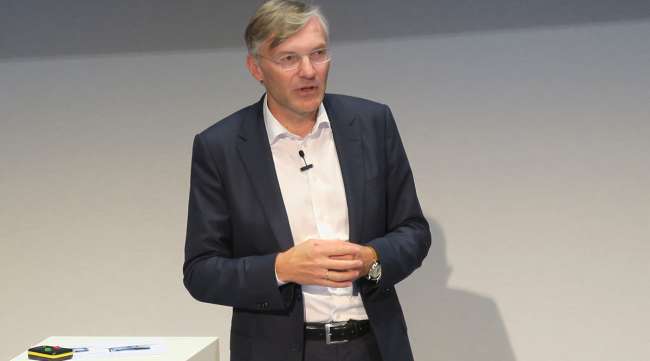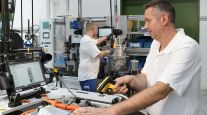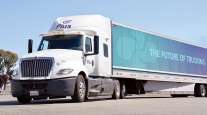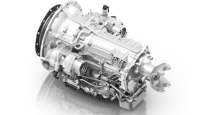ZF Outlines Tech Strategy, Including Automated, Electric

FRIEDRICHSHAFEN, Germany — The leader of global supplier ZF believes that commercial applications for automated technology could soon become a reality in certain controlled situations, but believes broader deployment in congested and high-traffic areas will take awhile.
“In clearly defined fields of application, such as mining, farming and freight yards, the advantages of automation can show their strength very soon,” said Wolf-Henning Scheider, the company’s CEO, during a June 26 event for international media held here at the company’s headquarters to outline its worldwide strategy for developing and deploying various technologies, including electric power, integrated safety systems, vehicle motion control and automated driving.
ZF CEO Wolf-Henning Scheider told media in Germany today that “clearly defined” applications like mining and freight yards are the best commercial uses for automated tech. pic.twitter.com/ojUGWZL7HI — JoeHoward_TT (@JoeHoward_TT) June 26, 2018
When it comes to the future of automated driving, he expects the commercial market to lead the way.
“Automated driving functions will see a wider use in commercial vehicles much earlier than in the passenger market,” he said. “We believe autonomous technologies will become a standard in areas where they increase the operational security and reduce the operational costs. Here, the fruits are hanging lower because of immediate total cost of ownership benefits and less complexity.”
That complexity exists, however, in areas where congestion becomes an issue, he noted.
“We see the first potential in restricted areas,” Scheider said during a roundtable discussion with select media after his presentation, noting that the business case is easier to make for off-highway and passenger transport applications than for urban transportation. “The most difficult is urban traffic, so that I expect last,” he said.
Scheider sees much broader applications for electrification of various powertrains, an area where ZF already has considerable exposure, he said.
“ZF electrifies every kind of vehicle, from the bicycle to heavy-duty trucks,” he said during his presentation. “This represents an exceptional position in our industry. But we are not only relying on pure electric drive systems; we are also looking at hybridization and electrification of components in an integrated way.”

In our debut episode of RoadSigns, we ask: What does the move toward autonomy mean for the truck driver? Hear a snippet from Fred Andersky of Bendix, above, and get the full program by going to RoadSigns.TTNews.com.
Between now and 2025, he said the company projects “broad market penetration” for these technologies. For example, he projects that hybridization could reach 20% penetration in the long-distance hauling segment by the early 2020s. He noted that ZF currently is conducting endurance testing with its Traxon hybrid transmission in partnership with an OEM, which he did not identify.
Further, Scheider said that all-electric drivetrains could reach 20% market penetration for medium- and heavy-duty trucks by 2025, along with up to 30% penetration among city buses and delivery vans.
On the subject of integrated safety systems, which he said have become a “major topic” in the commercial vehicle sector over the past few years, Scheider said ZF is developing new interior concepts designed around occupant safety for use in conjunction with automated technology. He called the concept, “the cockpit of the future.”
Vehicle motion control, meanwhile, refers to the company’s efforts to address circumstances where drivers become distracted and shift focus from the road. At the event, he revealed a networking package from ZF that integrates steering, braking and electric power. Called Cubix, the program will, he said, have a “positive effect on the acceptance of automated functions” in light commercial vehicles, and will “revolutionize” the driving experience for passengers.




